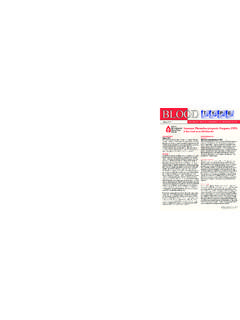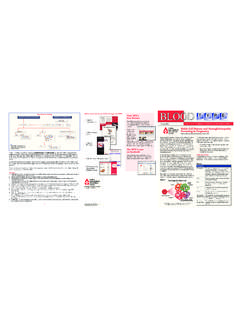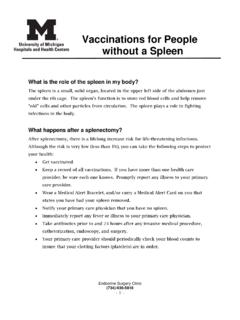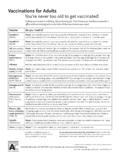Transcription of Immune Thrombocytopenic Purpura (ITP) - IHTC
1 Immune Thrombocytopenic Purpura (ITP):A New Look at an Old Disorder - Part II - TreatmentFall 2010 PAGE 48402 Harcourt Road, Suite 500 Indianapolis, IN 46260 TREATMENTS: WHEN, WHY AND WHAT -THE PEDIATRIC VERSUS ADULT PERSPECTIVEHow is a patient with ITP treated? Once the diagnosis of ITP has been confirmed the mostimportant question to address is whether an indication ispresent that would warrant treatment. Common treatmentmodalities utilized in both pediatric and adult ITP includeclose clinical monitoring with pharmacologic intervention,use of steroids, intravenous Immune globulin and decisions are individualized for each patient. Ingeneral, patients with platelet counts above 20,000-30,000cells/mm3 may only require close monitoring in the absenceof a planned surgical procedure, acute illnesses or anothersymptom of concern including bleeding. Treatment decisionsshould be grounded on a good working relationship betweenthe physician and patient should be cognizant of the ration-ale for observation only, and that they promptly reportsymptoms that might warrant further evaluation and/or a change in strategy.
2 CorticosteroidsIf therapy is indicated, patients may be initially treated with some form of corticosteroid with the most commonlyutilized formulations including prednisone, methylpred-nisolone, and dexamethasone. Pediatric patients are commonly treated with an initial dose of prednisone of 1-2 mg/kg for a duration of 1-2 weeks; some physicians utilize a weaning schedule while others do not based uponresponse to and length of therapy. The majority of patientsexperience some initial response to therapy, with only 30%or less representing durable responses maintained greaterthan 5 years after a single steroid treatment. Pulsed highdose dexamethasone administered over 4 days in monthlycycles up to 6 months has been shown to induce remissionseven in the chronic form of this disorder; the durability ofthese responses is not well Immune globulinIntravenous immunoglobulin (IVIG) is derived from the plasma of many blood donors.
3 When administered intra-venously in greater than replacement doses, a reduction inreticuloendothelial system clearance of antibody coatedplatelets ensues resulting in increased platelet counts. Inaddition, other pathophysiologic mechanisms have been purported to contribute to this therapy's efficacy includingincreased clearance of pathogenic platelet antibodiesthrough the presence of anti-idiotypic antibodies. IVIG hasbeen shown to be effective in the treatment of acute andchronic ITP. A variety of dosing regimens have been reportedincluding lower dose regimens of ~200-500 mg/kg/day for 5 days or higher dose regimens of ~1 gram/kg/day for 1-2days. Reported side effects include those associated withmild serum sickness including urticarial rash, but may alsoinclude a severe headache associated with aseptic formulations should be avoided in patients withrenal dysfunction. Few patients experience durable respons-es to IVIG administered as a sole therapy; however, this hasbeen reported most commonly in the pediatric population in acute disease in patients less than 8-10 years of Immune based therapeutic utilized as first lineagent for treatment of ITP is Anti-D immunoglobulin.
4 Anti-D is a concentrated formulation of antibodies againstthe red blood cell antigen "D" also commonly known as partof the Rh complex. Anti-D is effective only in patients withan Rh positive blood type and with an intact spleen. Thepathophysiologic mechanism of action of Anti-D is thoughtto be similar to that of IVIG with decreased reticuloendothe-lial system clearance of antibody coated platelets; this mayoccur through occupation of the majority of Fc receptorswith numerous antibody-coated erythrocytes. Anti-D is commonly administered as an intravenous infusion for thetreatment of ITP. Reported side effects are similar to thoseobserved with IVIG including allergic reactions. Although a decrease in hemoglobin is expected with the use of Anti-D, exaggerated intravascular red cell hemolysis mayoccur resulting in acute anemia, multi-system organ failure, difficulty breathing, and even death. In December 2009, the FDA revised the package insert to highlight these warnings while also suggesting additional tests and patientmonitoring to identify and treat those patients at highestrisk.
5 Patients should immediately report back pain, shakingchills, fever, discolored urine, decreased urine output, sud- Copyright Indiana Hemophilia &Thrombosis Center, Inc. 2010 ADDITIONAL RESOURCES: Patients requiring evaluation or further management of ITP may be referred to the IHTC by calling web resources exist for patients with ITP:1. Patient Information and Support Groups Platelet Disorder Support Association PDSA: The ITP Support Association: Children's Cancer and Blood Foundation: Vaccine safety #thrombocytopenia3. Medication Support Programs WinRho: Nplate: Pomacta: request a copy of Part I - Immune Thrombocytopenia Purpura (ITP): A New Look at an Old Disorder, contact the IHTC at weight gain, fluid retention, edema and/or shortness ofbreath to their physician. RituximabChronic and/or refractory ITP has been treated with otherimmune modulating agents including Rituximab, an anti-CD20 antibody that decreases B-lymphocytes.
6 Modulationand reduction in B-lymphocytes interferes with the B-Cell-T-cell interaction pivotal to continued antibody formationand resultant platelet destruction observed in ITP. Rituximabhas been demonstrated in certain studies to be efficacious as an initial treatment in selected patients, most commonlyadult patients with strong markers of refractory than 50% of patients in early studies showed aresponse to Rituximab with the majority of responses maintained over one it is generally used as an alternative therapy after failureof other agents it is still unknown whether use as a first line agent would increase the number of observed durableresponses. Rituximab is generally well tolerated despite infusion reactions that often abate with a slower infusionrate and usually do not recur with subsequent causes mild lymphopenia; there is no evidence tosupport the need for antibacterial prophylaxis. A more con-cerning yet less common adverse event associated with theuse of this agent has been the development of progressivemultifocal leukoencephaly in previously treated is one of the oldest and most common treatments for ITP.
7 Splenectomy is typically reserved for patients who have failed other medical therapies, oftenincluding Rituximab. The majority of patients experiencedurable responses (~66%). Splenectomy is now commonlyperformed laparoscopically, and as such the overall acute morbidity is fairly low. Patients in whom elective splen-ectomy is considered should receive required supplementalvaccinations at least 2 weeks prior to the procedure including consideration of pneumococcal, meningococcal,and Hemophilus influenza B vaccinations. For patients who have been recently or chronically treated with corticos-teroids, the use of stress doses should be administered forcoverage during and after the procedure. Currently, splenec-tomy is postponed for longer periods of time with increasedor repeated utilization of currently available agents includingIVIG, anti-D, or Rituximab; splenectomy is less commonlyutilized in the pediatric populations as compared to adults.
8 Patients may relapse post splenectomy; relapses most commonly occur in the first two years post-procedure. If patients relapse or are refractory to splenectomy, the presence of an accessory spleen should be considered. Second-line therapiesOther medications have been demonstrated to have vari-able efficacy in the treatment of ITP. These agents includedanazol, cyclophosphamide, vincristine, azathioprine, anddapsone; the overall use of these agents is decreased com-pared to previously discussed agents and as such their clinicalefficacy has been less systematically evaluated. The use ofsecond-line agents should be pursued after consultation witha hematologist familiar with their use and the treatment ofacute and chronic approved agentsA newer class of agents for treatment of ITP is medicationsthat are second-generation thrombopoietic growth (TPO) glycoprotein hormone producedmainly by the liver and the kidney that regulates the produc-tion of platelets by the bone marrow.
9 The first-generationrecombinant forms of human TPO were discontinued afterhealthy volunteers developed antibodies against TPO andsubsequent second-generation formulations have been developedwithout significant resemblance to human TPO but with the ability to stimulate the TPO receptor. These new agents,Romiplostim (AMG 531 or Nplate ) and Eltrombopag(Promacta ) are FDA-approved for chronic ITP. In general,these agents are fairly well tolerated; care must taken withtheir use due to an increased incidence of bone marrow reticulin deposition. To date, this appears to be reversible andthere does not appear to be a clinical correlation between reti-culin deposition to other bone marrow failure syndromes,including myelofibrosis. Overall, these medications have a proven efficacy in maintaining clinically "safe" plateletcounts; however the response is lost when the agent is discontinued. The current adverse event profile appears tolerable, yet patients do require close continued observation.
10 Platelet transfusionsPatients who experience emergent, life-threatening bleed-ing, such as central nervous system or gastrointestinal with altered vital signs or significant anemia, may be treatedwith a platelet transfusion in addition to use of other platelets would be expected to have an alteredhalf-life due to the presence of anti-platelet antibodies; however, when administered acutely in larger doses, from a single donor, or as a continuous infusion, they may achievehemostasis either in association with or in the absence of an improvement in the platelet count. Supportive agentsOther hemostatic agents may be utilized in specific patientsor types of bleeding events. These agents are not well stud-ied in this specific disorder but do have well documented usein other bleeding diatheses such as hemophilia. Examples of these adjunctive therapies include antifibrinolytic agentssuch as tranexamic acid and aminocaproic acid that are use-ful for mucosal bleeding.





